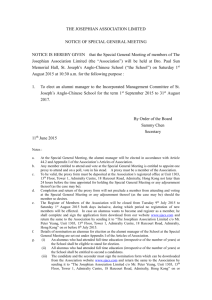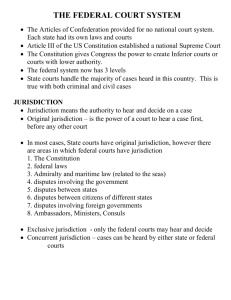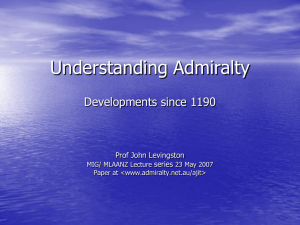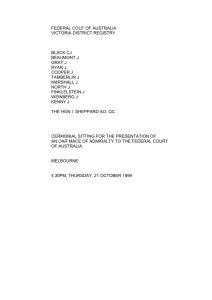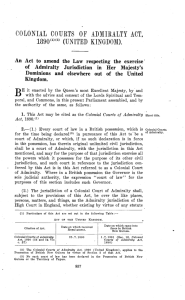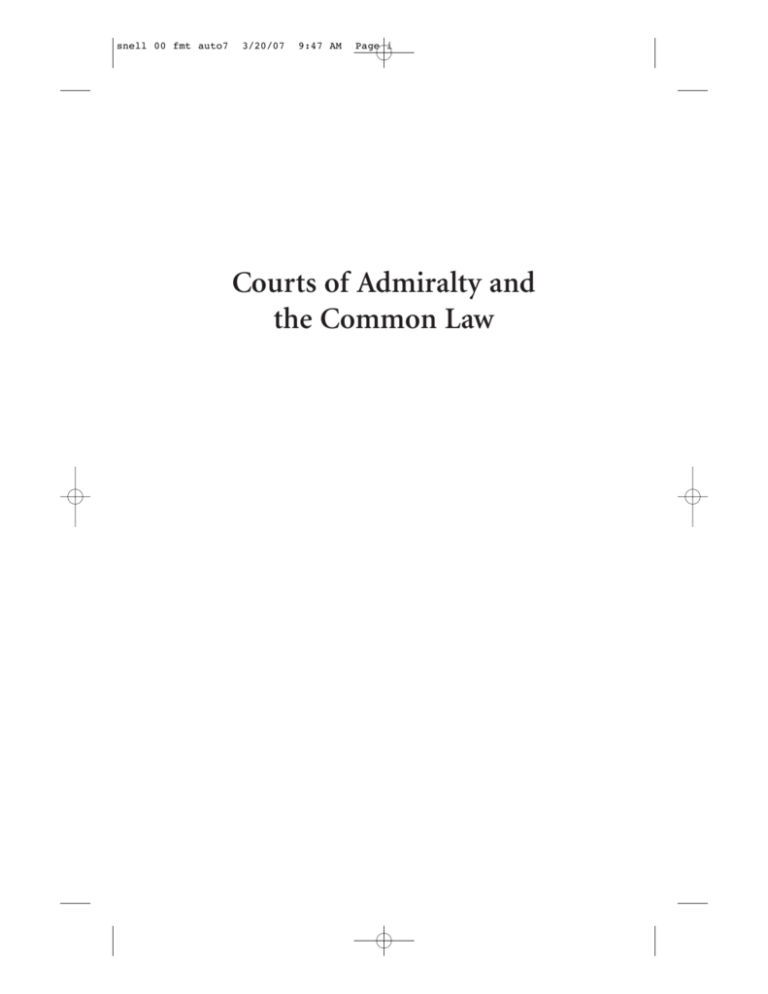
snell 00 fmt auto7
3/20/07
9:47 AM
Page i
Courts of Admiralty and
the Common Law
snell 00 fmt auto7
3/20/07
9:47 AM
Page ii
snell 00 fmt auto7
3/20/07
9:47 AM
Page iii
Courts of Admiralty and
the Common Law
Origins of the American Experiment
in Concurrent Jurisdiction
Steven L. Snell
J.D., LL.M., J.S.D
Carolina Academic Press
Durham, North Carolina
snell 00 fmt auto7
4/27/07
8:39 AM
Page iv
Copyright © 2007
Steven L. Snell
All Rights Reserved
Library of Congress Cataloging-in-Publication Data
Snell, Steven L.
Courts of admiralty and the common law: origins of the American
experiment in concurrent jurisdiction / by Steven L. Snell. -- [2nd ed.]
p. cm.
Includes bibliographical references and index.
ISBN 13: 978-1-59460-173-6 ISBN 10: 1-59460-173-9 (alk. paper)
1. Admiralty--United States--History. 2. Jurisdiction--United States. 3.
Common law. I. Title.
KF1112.S645 2006
343.7309'6--dc22
2006010306
Carolina Academic Press
700 Kent Street
Durham, North Carolina 27701
Telephone (919) 489-7486
Fax (919) 493-5668
www.cap-press.com
Printed in the United States of America
snell 00 fmt auto7
3/20/07
9:47 AM
Page v
To Betty M. Snell
snell 00 fmt auto7
3/20/07
9:47 AM
Page vi
snell 00 fmt auto7
3/20/07
9:47 AM
Page vii
Contents
The Sources:
A Note on Translation, Spelling, and Punctuation
Introduction
Maritime Commerce and the Eighteenth-Century
American Economy
The Impact of Independence on American Maritime Trade
Maritime Commerce and American Foreign Policy
ix
3
13
25
32
Chapter I
The Continuity of Substantive Maritime Law
The Struggle for Jurisdiction
Concurrent Jurisdiction
45
50
83
112
Chapter II
The Early History of Maritime Litigation in the American Colonies
Vice Admiralty Courts and the Navigation Acts
The Provincial Vice Admiralty Courts
Factors Influencing Choice of Forum
Vice Admiralty Jurisdiction on the Eve of the Revolution:
A Final Appraisal
125
131
136
149
180
Chapter III
The Maritime Jurisdiction of the States
The Constitutional Convention
General Debate over Article III in the States’ Ratifying Conventions
Admiralty and the Concept of Concurrent Jurisdiction in the
States’ Ratifying Conventions
207
211
232
259
vii
202
271
snell 00 fmt auto7
viii
3/20/07
9:47 AM
Page viii
CONTENTS
Chapter IV
Admiralty Jurisdiction and the Structure of the Federal Courts
Concurrent Admiralty and Maritime Jurisdiction
The Judiciary Act and the Constitution
Admiralty Jurisdiction and Substantive Law
The Law of Nations in Late Eighteenth-Century America
Lex Maritima As Part of the Law of Nations
Substantive Maritime Law and Concurrent Maritime Jurisdiction:
Recapitulation
281
289
304
312
321
332
349
Chapter V
Blue Water: International and Coastal Maritime Commerce
in the Antebellum Republic
Continental Influence on the Early Federal Courts
Uniformity and the General Maritime Law
Joseph Story and the Maritime Law
Brown Water: Inland Navigation in the Antebellum Republic
Federal Jurisdiction over Inland Waters
361
366
373
380
385
395
400
Conclusion
415
Bibliography
435
Index
457
353
snell 00 fmt auto7
3/21/07
10:26 AM
Page ix
The Sources:
A Note on Translation,
Spelling, and Punctuation
The history of English admiralty jurisdiction is interwoven inextricably with
the history of the common law—and with eighteenth-century America’s efforts
to create a viable judicial system in the early years following independence. While
their letters, journals, speeches, and published writings often resonated with the
political philosophy of the Enlightenment and the rhetoric of the Revolution,
the founders of the new republic were at heart practical men, who revered experience as much as abstract theory in shaping the structure of the new nation.
Maritime commerce and adjudication of maritime disputes touched the daily
lives of the Framers of the Constitution and the members of the first Congress,
and these experiences influenced their thought at least as profoundly as did
Montesquieu’s theories on the separation of powers. One cannot fully grasp the
intricacies of the debate over the judicial branch without some understanding
of the history of American admiralty jurisdiction. From the colonial period
through the 1780s, America’s maritime courts served as the crucible in which
solutions for the practical problems of jurisdiction were tested. Thus the surviving records of the admiralty courts, the writings of the merchants and legalpractitioners who litigated in them, and the published works of the jurists who
sought to define the scope of their jurisdiction together provide an invaluable
resource for those seeking a better understanding of the choices that America’s
founding generation made in formulating the structure of the federal judiciary.
Methodologically, “Courts of Admiralty and the Common Law” seeks to shed light
on the origins of modern admiralty jurisdiction—as well as on the origins of
the federal courts—principally through examining primary sources compiled
over a period spanning from antiquity through the eighteenth century.
In addition to the ancient writings — from Cicero to the Corpus Juris
Civilis—some scholarly legal works of the early modern period originally were
written in Latin. In order to facilitate ease in reading and to make the inforix
snell 00 fmt auto7
x
3/20/07
9:47 AM
Page x
THE SOURCES
mation in this book available to a wide audience, I have translated the Latin
sources that I have quoted in the main text. Regrettably, translation at best
provides a crude reflection of a text in its original language. Nuances and ambiguities of words and phrases in one language lack perfect analogues in another, forcing the translator to exercise judgment as to which nuances and ambiguities should be stressed in the translation and which may be deemphasized
safely (or omitted entirely). A casual glance at how several different (and
equally competent) translators render the same Latin passage into English reveals how inevitably subjective the process of translating is. Readers proficient
in Latin naturally would prefer to make these judgments for themselves. Out
of respect for their preference for reading and interpreting the quoted passages
in the original language, I have opted also to reproduce the Latin verbatim in
the footnotes.
No effort has been made to render the various sources quoted in “Courts
of Admiralty and the Common Law” into modern English. Archaic spelling,
syntax, and punctuation have been preserved throughout. Moreover, as standardized spelling and rules of punctuation are comparatively recent developments in the English language, it is not always possible to distinguish between
archaic forms and printers’ errors. Some of the quoted material is derived from
unpublished sources, such as journals, letters, and lecture-notes, in which the
authors employed their own forms of abbreviation and often exercised little
care in spelling — with the result that one word may have more than one
spelling within the same text. The use of “[sic]” to designate departures from
standard usage is more of an art than an exact science. I generally have omitted it entirely in medieval and early modern texts, where the reader should
not expect modern spelling, reserving its use for inconsistencies in spelling
within the same text or for those rare instances in which an archaic form of a
word departs so far from its modern equivalent that it requires some clarification. In documents of the eighteenth century and later, in which grammar,
spelling, and punctuation have assumed more modern form, I have used
“[sic]” more liberally to highlight printers’ errors and individual authors’ personal eccentricities in spelling.
Steven L. Snell
Baltimore, Maryland
June, 2006

